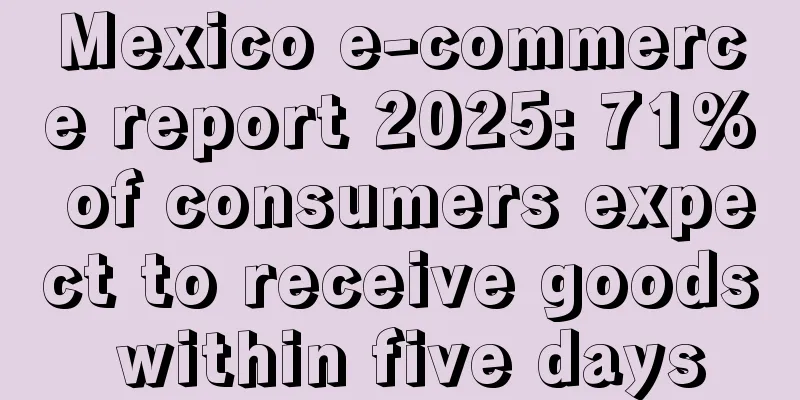Mexico e-commerce report 2025: 71% of consumers expect to receive goods within five days

|
It is learned that recently, according to the "Mexico E-commerce Report 2025" released by Elogia, the Mexican e-commerce market continues to expand, and consumers' online shopping frequency and spending continue to increase. The report shows that 45% of Mexican consumers shop online every week, with an average purchase of 1,203 Mexican pesos. Mercado Libre (77%) and Amazon (73%) are the preferred platforms for consumers, dominating in categories such as fashion, electronics and beauty products. Among the factors that influence consumers' purchasing decisions, price and promotion (77%), platform quality and trust (74%), and shopping convenience (73%) are the most critical factors. At the same time, consumers' expectations for fast delivery are increasing, with 71% of consumers saying they hope to receive their purchased goods within five days. This trend shows that e-commerce platforms need to continuously optimize delivery speed to meet consumer needs. Despite the strong performance of the Mexican e-commerce market, after-sales service still faces challenges. About 30% of consumers said they encountered difficulties in the return process, and 74% of Mexican consumers said they would choose to abandon a brand if they encountered unsatisfactory customer service. Therefore, improving the quality of after-sales service and optimizing customer support will become an important issue for e-commerce platforms. In terms of device usage, smartphones have become the preferred device for online shopping for Mexican consumers. 92% of consumers prefer to shop through mobile apps rather than traditional e-commerce websites. This trend requires e-commerce platforms to strengthen the optimization of mobile user experience to ensure that consumers can shop smoothly on their phones. In addition, the Mexican e-commerce market is actively adopting new technologies such as live shopping and artificial intelligence. The report mentioned that 58% of sellers plan to use live shopping tools (such as TikTok Shop and Instagram Shopping) in the future, while 53% of sellers intend to adopt artificial intelligence-based technologies (such as ChatGPT) to enhance the personalization and automation of the shopping experience. The application of these technologies will help e-commerce platforms stand out from the competition. The report also highlights the "omnichannel" trend in the e-commerce industry. 79% of consumers said they would combine online and offline shopping channels to make purchases, showing consumers' demand for multiple shopping channels. Therefore, e-commerce platforms need to strategically integrate online and offline resources to provide a seamless shopping experience. Author✎ Summer/ |
<<: Clothing is the most returned category by American consumers, with size issues ranking first
>>: 13,000 dryers sold on Amazon and other platforms have been recalled! There is a fire hazard
Recommend
What is AliPrice Seller Assistant? AliPrice Seller Assistant Review
AliPrice Seller Assistant (Dongguan Chengpai Netwo...
Addicted to free stuff? Temu's free shopping tutorial goes viral!
Yesterday, #Is the refund-only policy of e-commerc...
What is a Quark? Quark Review
Quarkscm is an export distribution platform and a ...
What is the Amazon Small Business of the Year Award? Review of the Amazon Small Business of the Year Award
Amazon officially announced that it will launch th...
After five overseas expansions, Kuaishou has found its “second curve” in commercialization
On January 28, the 2023 Kwai for Business Annual A...
Tips | 5 tips for gaining fans on your Facebook page
Public Pages are important business cards for comp...
What is the Amazon1688 forum? Amazon1688 forum review
The most professional Amazon seller forum in the U...
What is Urban Ladder? Urban Ladder Review
Urban Ladder was founded in 2012. It has more than...
Multiple brands are going public! The outdoor barbecue business in the United States is booming
A new track is quietly becoming popular. As outdoo...
Amazon FBA claims time limit shortened, sellers have a solution!
Recently, Amazon has adjusted its FBA refund claim...
What is Banggood Technology? Banggood Technology Review
Banggood Technology Co., Ltd. (Banggood Technology...
Breaking news! Amazon has removed many brands. You can try the following methods
text Recently, my friends and forums have been bu...
What is Primary Color Consulting? Primary Color Consulting Review
Original Color Consulting is a comprehensive consu...
Increase exposure and views! Pinterest offers mobile deep linking for retailers!
Pinterest has announced that it will provide retai...
What is Yayi Intellectual Property? Yayi Intellectual Property Review
Shenzhen Yayi Intellectual Property Agency Co., Lt...









